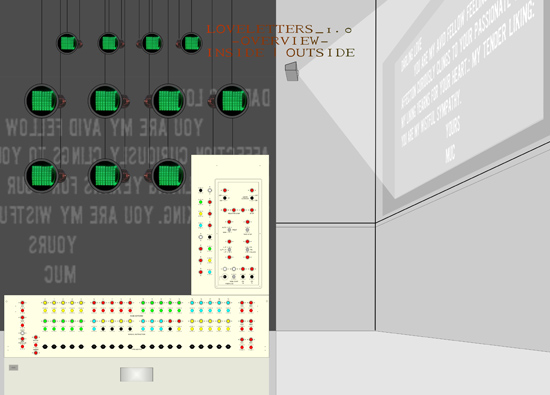LoveLetters_1.0 MUC=Resurrection. A Memorial.2009 / Computer Art InstallationDavid Link  From August 1953 to May 1954 strange love-letters appeared on the notice board of Manchester University's Computer Department: DARLING SWEETHEART YOU ARE MY AVID FELLOW FEELING. MY AFFECTION CURIOUSLY CLINGS TO YOUR PASSIONATE WISH. MY LIKING YEARNS FOR YOUR HEART. YOU ARE MY WISTFUL SYMPATHY: MY TENDER LIKING. YOURS BEAUTIFULLY M. U. C. The acronym M.U.C. stood for "Manchester University Computer", the earliest electronic, programmable, and universal calculating machine worldwide; the fully functional prototype was completed in June 1948 and was based on Williams tubes as means of volatile storage. One of the very first software developers, Christopher Strachey (1916–1975), had used the built-in random generator of the Ferranti Mark I, the first industrially produced computer of this kind, to generate texts that are intended to express and arouse emotions. The installation LoveLetters_1.0 consists of two parts. Inside a narrow box, the user is enclosed with a functional replica of the Ferranti Mark I, which conveys an impression of the functionality and potential risks of the first computer. It executes the original code of Strachey's software if the visitor employs the right switches of the reconstructed user interface console. A love letter is generated and projected outside on a huge surface in a public building, where everybody can read it. If the user of the installation manages to type his or her name in Baudot code on the computer's type-writer buttons, the love letter will carry this signature. LoveLetters_1.0 allows people to publicly address algorithmically generated love letters to each other. Pushing a lighted button copies the poem to the visitor's USB stick. Additionally, it can be downloaded from the project's website. Once a day, at a randomly selected moment, the machine autonomously prints a love letter on the reconstructed Creed 7 teleprinter from 1931. (This machine helped organising the British response to Hitler's threats.) When the printout is complete, the Mark 1 plays "God Save the Queen" on the "hooter" (loudspeaker). On an electronic tabloid display, the user can investigate the historical background of the machine by studying authentic documents and photos from the time. The lab notebook of one of the main constructors of the machine, Geoff Tootill, is presented alongside the maintenance engineers' logbook from July 1951, all the manuals for the machine (Turing 1952, Prinz 1954) and several sets of photos. David Link (born 1971 in Düsseldorf) Computer artist, theorist and programmer based in Cologne. Since 1997, his media art installations have been exhibited at numerous international festivals. His work "Poetry Machine" (2001), an interactive text generator based on semantic networks, is part of the permanent collection at ZKM | Centre for Art and Media, Karlsruhe. Latest projects include "ECHOHCE" (a rock concert together with FM Einheit and Jamie Lidell) and "Chorus" (an elliptic LED ticker of 10 m diameter that is suspended above the terrace of a cafe and reflects the topics of conversation of the visitors). In 2004, he took his PhD in philosophy at Humboldt-University, Berlin, and the Academy of Media Arts Cologne, with a thesis on text generating algorithms in the early years of computer development ("Poetry Machines / Machine Poetry", Munich: Fink, 2007). His current research focuses on the convergence of mathematics and engineering in the early 20th century. · http://alpha60.de/ © Photo: David Link David Link, LoveLetters_1.0. MUC=Resurrection. A Memorial., 2009, Computer Art Installation, loaned by the artist Support in every respect: Christopher P Burton MSc CEng. Vintage technical support: Klaas Henschel, Thomas Völker, Klatho GmbH, Hamburg; Uwe Koch; Robert O'Kane; Kaya Wilbrandt; Alex Farfan. Vintage material support: Andy Coleman; Martin Edmunds; Kevin Murrell, Tony Sale, The National Museum of Computing, Bletchley Park, London. Vintage informational support: Martin Campbell-Kelly; Simon Lavington; Brian Napper; Ludwell Sibley; Tilly Blyth, Science Museum, London; Computer Conservation Society, UK. Produced by: Kunststiftung NRW; ZKM | Center for Art and Media, Karlsruhe. |
